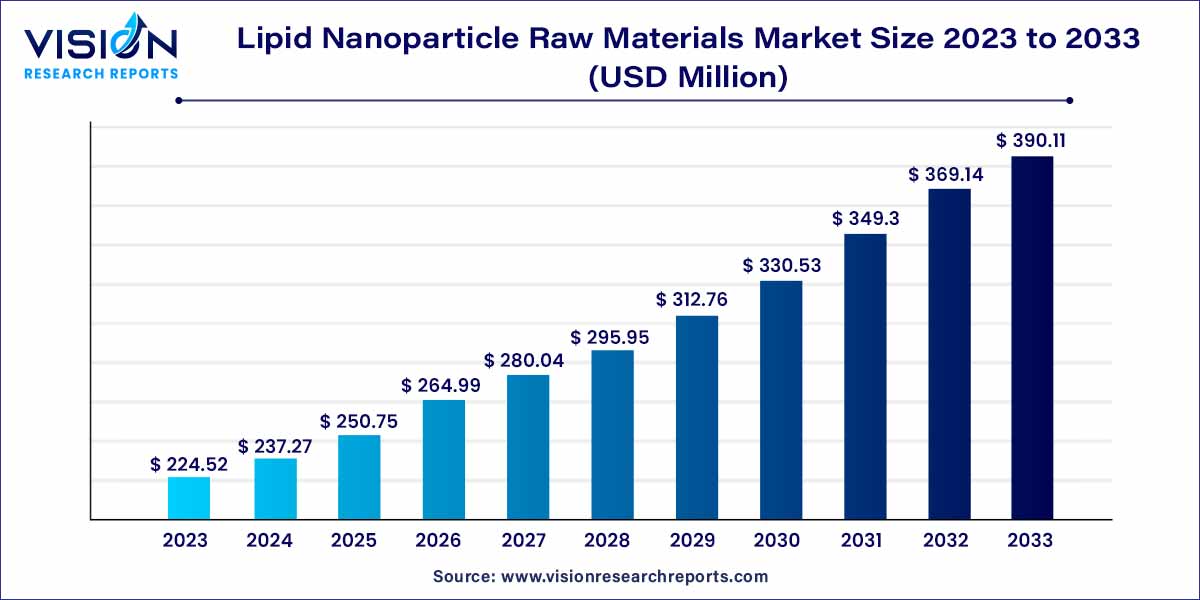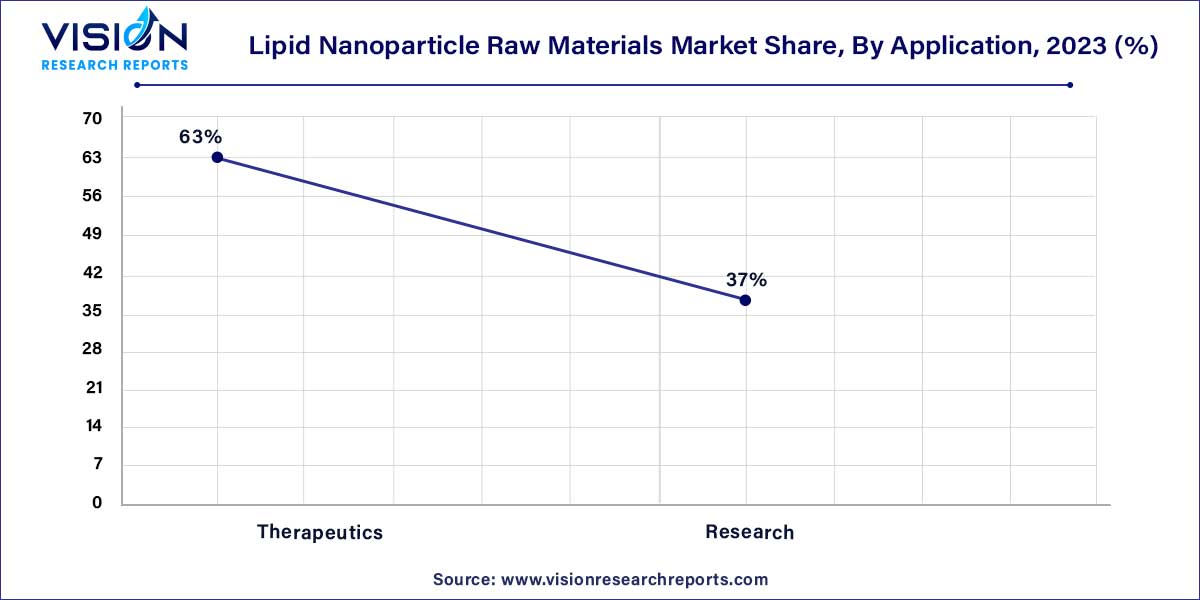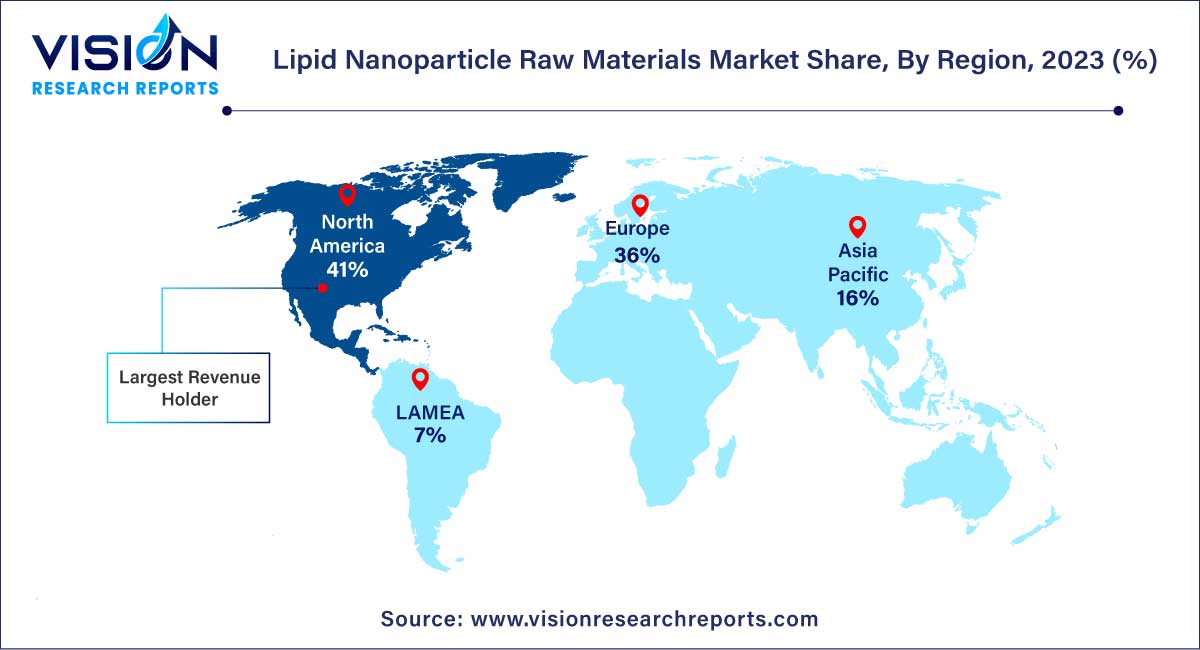The global lipid nanoparticle raw materials market size was estimated at around USD 224.52 million in 2023 and it is projected to hit around USD 390.11 million by 2033, growing at a CAGR of 5.68% from 2024 to 2033. The lipid nanoparticle raw materials market is driven by the escalating demand for advanced drug delivery systems and nanotechnology applications.

The growth of the lipid nanoparticle raw materials market is propelled by several key factors. Firstly, the escalating demand for advanced drug delivery systems has become a significant driver, with lipid nanoparticles serving as crucial components in these systems. The ability of lipid nanoparticles to encapsulate diverse therapeutic payloads, enhancing targeted and controlled drug delivery, has contributed to their increased adoption. Additionally, the field of nanotechnology is witnessing rapid advancements, further fueling the market's growth. The unique properties of lipid nanoparticles make them ideal candidates for various applications, including diagnostics and imaging, adding to their overall market appeal. Moreover, the surge in investments in research and development by pharmaceutical and biotech companies has played a pivotal role in expanding the lipid nanoparticle raw materials market. This trend is expected to lead to the discovery of novel formulations and applications, contributing to sustained market growth in the foreseeable future.
In 2023, the therapeutics segment emerged as the market leader, commanding the largest share of revenue at 63%. This dominance can be attributed to the widespread use of Lipid Nanoparticles (LNPs) in the pharmaceutical sector for drug delivery. LNPs exhibit a remarkable capability to encapsulate and transport therapeutic agents to precise targets within the body. As the demand for innovative drug delivery systems continues to rise, there is a corresponding surge in the need for lipid nanoparticle raw materials.

Concurrently, the research segment is poised to register the fastest CAGR during the forecast period. This surge is fueled by the escalating demand for efficient drug delivery systems and the extensive utilization of lipid nanoparticles in diverse research endeavors. Lipid nanoparticles play a pivotal role in the formulation of novel drugs, leveraging advantages such as biocompatibility, high drug loading capacity, and controlled drug release. Additionally, the increasing prevalence of chronic diseases like cancer, coupled with the imperative for precise drug delivery, further amplifies the demand for LNPs in research applications.
In 2023, the kits segment emerged as the market leader, capturing the largest share of revenue at 55%. This dominance is propelled by factors such as the increasing prevalence of Alzheimer's disease and glaucoma, driving the demand for more effective treatment options through Lipid Nanoparticle (LNP) drug delivery. Additionally, the continuous development of novel lipid-based drug delivery systems and the rising adoption of personalized medicine are anticipated to be key contributors to the robust growth of the kits product segment.
Concurrently, the reagent segment is expected to witness substantial growth at a noteworthy CAGR during the forecast period. Reagents, critical raw materials in LNP production, are in high demand, driven by the increasing overall demand for lipid nanoparticles. The surge in investments in pharmaceutical research and development activities, coupled with the rising prevalence of chronic diseases, is anticipated to further boost the reagent segment, contributing to overall market growth.
In 2023, the infectious diseases segment dominated the market, securing the largest share of revenue at 47%, and is poised to exhibit the fastest Compound Annual Growth Rate (CAGR) during the forecast period. This prominence can be attributed to the pivotal role of Lipid Nanoparticles (LNPs) in the development of mRNA vaccines, particularly in the global battle against COVID-19. LNPs play a crucial role in safeguarding mRNA from degradation within the body and facilitating its delivery to cells. The substantial increase in demand for lipid nanoparticle raw materials is a direct consequence of the widespread implementation of vaccination programs worldwide.
Concurrently, the cancer disease segment is expected to witness a significant CAGR during the forecast period. LNPs play a vital role in drug delivery, specifically targeting cancer cells to enhance treatment efficacy. The raw materials essential for manufacturing these nanoparticles encompass lipids, surfactants, and polymers. The World Health Organization (WHO) estimates that the number of new cancer cases will surpass 35 million by 2050, marking a substantial 77% increase from the estimated 20 million cases in 2022. This escalating burden of cancer, coupled with the potential of LNPs in cancer treatment, has spurred considerable research and development efforts.
In 2023, pharmaceutical and biotechnology companies asserted their dominance in the market, capturing the largest revenue share at 58%. These companies play a pivotal role in utilizing Lipid Nanoparticle (LNP) raw materials to develop advanced drug delivery systems. These systems aim to enhance efficacy, safety, and specificity across a spectrum of therapeutic applications, including cancer treatment, gene therapy, and personalized medicine. The surge in demand for lipid nanoparticle raw materials can be attributed to pharmaceutical and biotechnology companies actively seeking reliable and high-quality sources to manufacture their innovative products.
Simultaneously, the academic and research institutes segment is anticipated to register the fastest Compound Annual Growth Rate (CAGR) during the forecast period. These institutes conduct crucial preclinical studies to assess the safety, efficacy, and pharmacokinetics of lipid nanoparticle-based drug delivery systems within relevant disease models. These studies generate valuable data on biodistribution, tissue targeting, and the therapeutic potential of lipid nanoparticles loaded with various drugs or therapeutic agents. Positive preclinical outcomes serve as a catalyst for translating promising formulations into clinical trials, propelling the demand for raw materials at the scale-up stages. The expanding landscape of preclinical studies evaluating lipid nanoparticle-based drug delivery systems correlates with a rising demand for raw materials used in formulating and manufacturing these nanoparticles.
In 2023, North America asserted its dominance in the market, securing a substantial revenue share of 41%. This prominence is largely attributed to the robust pharmaceutical and biotechnology industry prevalent in the region. The U.S. and Canada, in particular, host pharmaceutical companies and biotech firms that heavily invest in research and development, consequently fueling the demand for lipid nanoparticle-based drug delivery systems. The evolving landscape towards biologics and gene therapy products in North America has opened up opportunities for lipid nanoparticle-based delivery systems. Lipid nanoparticles play a crucial role in delivering nucleic acids, including mRNA, siRNA, and gene-editing tools, for the treatment of various diseases. The approval of mRNA vaccines for COVID-19 has further underscored the immense potential of lipid nanoparticles in the gene therapy.

Meanwhile, the lipid nanoparticle raw materials market in Asia Pacific is poised to exhibit the fastest Compound Annual Growth Rate (CAGR) over the forecast period. The region's rapid economic growth has led to increased healthcare expenditure and heightened investments in medical research and development. The improvement of healthcare infrastructure and the expanding access to healthcare services are driving a growing demand for advanced drug delivery systems, including lipid nanoparticles.
By Application
By Product
By Disease Indication
By End-use
By Region
Chapter 1. Introduction
1.1. Research Objective
1.2. Scope of the Study
1.3. Definition
Chapter 2. Research Methodology
2.1. Research Approach
2.2. Data Sources
2.3. Assumptions & Limitations
Chapter 3. Executive Summary
3.1. Market Snapshot
Chapter 4. Market Variables and Scope
4.1. Introduction
4.2. Market Classification and Scope
4.3. Industry Value Chain Analysis
4.3.1. Raw Material Procurement Analysis
4.3.2. Sales and Distribution Channel Analysis
4.3.3. Downstream Buyer Analysis
Chapter 5. COVID 19 Impact on Lipid Nanoparticle Raw Materials Market
5.1. COVID-19 Landscape: Lipid Nanoparticle Raw Materials Industry Impact
5.2. COVID 19 - Impact Assessment for the Industry
5.3. COVID 19 Impact: Global Major Government Policy
5.4. Market Trends and Opportunities in the COVID-19 Landscape
Chapter 6. Market Dynamics Analysis and Trends
6.1. Market Dynamics
6.1.1. Market Drivers
6.1.2. Market Restraints
6.1.3. Market Opportunities
6.2. Porter’s Five Forces Analysis
6.2.1. Bargaining power of suppliers
6.2.2. Bargaining power of buyers
6.2.3. Threat of substitute
6.2.4. Threat of new entrants
6.2.5. Degree of competition
Chapter 7. Competitive Landscape
7.1.1. Company Market Share/Positioning Analysis
7.1.2. Key Strategies Adopted by Players
7.1.3. Vendor Landscape
7.1.3.1. List of Suppliers
7.1.3.2. List of Buyers
Chapter 8. Global Lipid Nanoparticle Raw Materials Market, By Application
8.1. Lipid Nanoparticle Raw Materials Market, by Application, 2024-2033
8.1.1. Therapeutics
8.1.1.1. Market Revenue and Forecast (2021-2033)
8.1.2. Research
8.1.2.1. Market Revenue and Forecast (2021-2033)
Chapter 9. Global Lipid Nanoparticle Raw Materials Market, By Product
9.1. Lipid Nanoparticle Raw Materials Market, by Product, 2024-2033
9.1.1. Ionizable lipids
9.1.1.1. Market Revenue and Forecast (2021-2033)
9.1.2. Reagents
9.1.2.1. Market Revenue and Forecast (2021-2033)
9.1.3. Other raw materials
9.1.3.1. Market Revenue and Forecast (2021-2033)
Chapter 10. Global Lipid Nanoparticle Raw Materials Market, By Disease Indication
10.1. Lipid Nanoparticle Raw Materials Market, by Disease Indication, 2024-2033
10.1.1. Cancer
10.1.1.1. Market Revenue and Forecast (2021-2033)
10.1.2. Infectious Diseases
10.1.2.1. Market Revenue and Forecast (2021-2033)
10.1.3. Blood Diseases
10.1.3.1. Market Revenue and Forecast (2021-2033)
10.1.4. Others
10.1.4.1. Market Revenue and Forecast (2021-2033)
Chapter 11. Global Lipid Nanoparticle Raw Materials Market, By End-use
11.1. Lipid Nanoparticle Raw Materials Market, by End-use, 2024-2033
11.1.1. Pharmaceutical & Biotechnology Companies
11.1.1.1. Market Revenue and Forecast (2021-2033)
11.1.2. Academic & Research Institutes
11.1.2.1. Market Revenue and Forecast (2021-2033)
11.1.3. Others
11.1.3.1. Market Revenue and Forecast (2021-2033)
Chapter 12. Global Lipid Nanoparticle Raw Materials Market, Regional Estimates and Trend Forecast
12.1. North America
12.1.1. Market Revenue and Forecast, by Application (2021-2033)
12.1.2. Market Revenue and Forecast, by Product (2021-2033)
12.1.3. Market Revenue and Forecast, by Disease Indication (2021-2033)
12.1.4. Market Revenue and Forecast, by End-use (2021-2033)
12.1.5. U.S.
12.1.5.1. Market Revenue and Forecast, by Application (2021-2033)
12.1.5.2. Market Revenue and Forecast, by Product (2021-2033)
12.1.5.3. Market Revenue and Forecast, by Disease Indication (2021-2033)
12.1.5.4. Market Revenue and Forecast, by End-use (2021-2033)
12.1.6. Rest of North America
12.1.6.1. Market Revenue and Forecast, by Application (2021-2033)
12.1.6.2. Market Revenue and Forecast, by Product (2021-2033)
12.1.6.3. Market Revenue and Forecast, by Disease Indication (2021-2033)
12.1.6.4. Market Revenue and Forecast, by End-use (2021-2033)
12.2. Europe
12.2.1. Market Revenue and Forecast, by Application (2021-2033)
12.2.2. Market Revenue and Forecast, by Product (2021-2033)
12.2.3. Market Revenue and Forecast, by Disease Indication (2021-2033)
12.2.4. Market Revenue and Forecast, by End-use (2021-2033)
12.2.5. UK
12.2.5.1. Market Revenue and Forecast, by Application (2021-2033)
12.2.5.2. Market Revenue and Forecast, by Product (2021-2033)
12.2.5.3. Market Revenue and Forecast, by Disease Indication (2021-2033)
12.2.5.4. Market Revenue and Forecast, by End-use (2021-2033)
12.2.6. Germany
12.2.6.1. Market Revenue and Forecast, by Application (2021-2033)
12.2.6.2. Market Revenue and Forecast, by Product (2021-2033)
12.2.6.3. Market Revenue and Forecast, by Disease Indication (2021-2033)
12.2.6.4. Market Revenue and Forecast, by End-use (2021-2033)
12.2.7. France
12.2.7.1. Market Revenue and Forecast, by Application (2021-2033)
12.2.7.2. Market Revenue and Forecast, by Product (2021-2033)
12.2.7.3. Market Revenue and Forecast, by Disease Indication (2021-2033)
12.2.7.4. Market Revenue and Forecast, by End-use (2021-2033)
12.2.8. Rest of Europe
12.2.8.1. Market Revenue and Forecast, by Application (2021-2033)
12.2.8.2. Market Revenue and Forecast, by Product (2021-2033)
12.2.8.3. Market Revenue and Forecast, by Disease Indication (2021-2033)
12.2.8.4. Market Revenue and Forecast, by End-use (2021-2033)
12.3. APAC
12.3.1. Market Revenue and Forecast, by Application (2021-2033)
12.3.2. Market Revenue and Forecast, by Product (2021-2033)
12.3.3. Market Revenue and Forecast, by Disease Indication (2021-2033)
12.3.4. Market Revenue and Forecast, by End-use (2021-2033)
12.3.5. India
12.3.5.1. Market Revenue and Forecast, by Application (2021-2033)
12.3.5.2. Market Revenue and Forecast, by Product (2021-2033)
12.3.5.3. Market Revenue and Forecast, by Disease Indication (2021-2033)
12.3.5.4. Market Revenue and Forecast, by End-use (2021-2033)
12.3.6. China
12.3.6.1. Market Revenue and Forecast, by Application (2021-2033)
12.3.6.2. Market Revenue and Forecast, by Product (2021-2033)
12.3.6.3. Market Revenue and Forecast, by Disease Indication (2021-2033)
12.3.6.4. Market Revenue and Forecast, by End-use (2021-2033)
12.3.7. Japan
12.3.7.1. Market Revenue and Forecast, by Application (2021-2033)
12.3.7.2. Market Revenue and Forecast, by Product (2021-2033)
12.3.7.3. Market Revenue and Forecast, by Disease Indication (2021-2033)
12.3.7.4. Market Revenue and Forecast, by End-use (2021-2033)
12.3.8. Rest of APAC
12.3.8.1. Market Revenue and Forecast, by Application (2021-2033)
12.3.8.2. Market Revenue and Forecast, by Product (2021-2033)
12.3.8.3. Market Revenue and Forecast, by Disease Indication (2021-2033)
12.3.8.4. Market Revenue and Forecast, by End-use (2021-2033)
12.4. MEA
12.4.1. Market Revenue and Forecast, by Application (2021-2033)
12.4.2. Market Revenue and Forecast, by Product (2021-2033)
12.4.3. Market Revenue and Forecast, by Disease Indication (2021-2033)
12.4.4. Market Revenue and Forecast, by End-use (2021-2033)
12.4.5. GCC
12.4.5.1. Market Revenue and Forecast, by Application (2021-2033)
12.4.5.2. Market Revenue and Forecast, by Product (2021-2033)
12.4.5.3. Market Revenue and Forecast, by Disease Indication (2021-2033)
12.4.5.4. Market Revenue and Forecast, by End-use (2021-2033)
12.4.6. North Africa
12.4.6.1. Market Revenue and Forecast, by Application (2021-2033)
12.4.6.2. Market Revenue and Forecast, by Product (2021-2033)
12.4.6.3. Market Revenue and Forecast, by Disease Indication (2021-2033)
12.4.6.4. Market Revenue and Forecast, by End-use (2021-2033)
12.4.7. South Africa
12.4.7.1. Market Revenue and Forecast, by Application (2021-2033)
12.4.7.2. Market Revenue and Forecast, by Product (2021-2033)
12.4.7.3. Market Revenue and Forecast, by Disease Indication (2021-2033)
12.4.7.4. Market Revenue and Forecast, by End-use (2021-2033)
12.4.8. Rest of MEA
12.4.8.1. Market Revenue and Forecast, by Application (2021-2033)
12.4.8.2. Market Revenue and Forecast, by Product (2021-2033)
12.4.8.3. Market Revenue and Forecast, by Disease Indication (2021-2033)
12.4.8.4. Market Revenue and Forecast, by End-use (2021-2033)
12.5. Latin America
12.5.1. Market Revenue and Forecast, by Application (2021-2033)
12.5.2. Market Revenue and Forecast, by Product (2021-2033)
12.5.3. Market Revenue and Forecast, by Disease Indication (2021-2033)
12.5.4. Market Revenue and Forecast, by End-use (2021-2033)
12.5.5. Brazil
12.5.5.1. Market Revenue and Forecast, by Application (2021-2033)
12.5.5.2. Market Revenue and Forecast, by Product (2021-2033)
12.5.5.3. Market Revenue and Forecast, by Disease Indication (2021-2033)
12.5.5.4. Market Revenue and Forecast, by End-use (2021-2033)
12.5.6. Rest of LATAM
12.5.6.1. Market Revenue and Forecast, by Application (2021-2033)
12.5.6.2. Market Revenue and Forecast, by Product (2021-2033)
12.5.6.3. Market Revenue and Forecast, by Disease Indication (2021-2033)
12.5.6.4. Market Revenue and Forecast, by End-use (2021-2033)
Chapter 13. Company Profiles
13.1. Merck KGaA
13.1.1. Company Overview
13.1.2. Product Offerings
13.1.3. Financial Performance
13.1.4. Recent Initiatives
13.2. Echelon Biosciences
13.2.1. Company Overview
13.2.2. Product Offerings
13.2.3. Financial Performance
13.2.4. Recent Initiatives
13.3. BroadPharm
13.3.1. Company Overview
13.3.2. Product Offerings
13.3.3. Financial Performance
13.3.4. Recent Initiatives
13.4. Avanti Polar Lipids
13.4.1. Company Overview
13.4.2. Product Offerings
13.4.3. Financial Performance
13.4.4. Recent Initiatives
13.5. CordenPharma International
13.5.1. Company Overview
13.5.2. Product Offerings
13.5.3. Financial Performance
13.5.4. Recent Initiatives
13.6. Creative Biolabs
13.6.1. Company Overview
13.6.2. Product Offerings
13.6.3. Financial Performance
13.6.4. Recent Initiatives
13.7. Biopharma PEG Scientific Inc.
13.7.1. Company Overview
13.7.2. Product Offerings
13.7.3. Financial Performance
13.7.4. Recent Initiatives
13.8. NOF AMERICA CORPORATION
13.8.1. Company Overview
13.8.2. Product Offerings
13.8.3. Financial Performance
13.8.4. Recent Initiatives
13.9. Polysciences, Inc.
13.9.1. Company Overview
13.9.2. Product Offerings
13.9.3. Financial Performance
13.9.4. Recent Initiatives
Chapter 14. Research Methodology
14.1. Primary Research
14.2. Secondary Research
14.3. Assumptions
Chapter 15. Appendix
15.1. About Us
15.2. Glossary of Terms
 Cross-segment Market Size and Analysis for
Mentioned Segments
Cross-segment Market Size and Analysis for
Mentioned Segments
 Additional Company Profiles (Upto 5 With No Cost)
Additional Company Profiles (Upto 5 With No Cost)
 Additional Countries (Apart From Mentioned Countries)
Additional Countries (Apart From Mentioned Countries)
 Country/Region-specific Report
Country/Region-specific Report
 Go To Market Strategy
Go To Market Strategy
 Region Specific Market Dynamics
Region Specific Market Dynamics Region Level Market Share
Region Level Market Share Import Export Analysis
Import Export Analysis Production Analysis
Production Analysis Others
Others